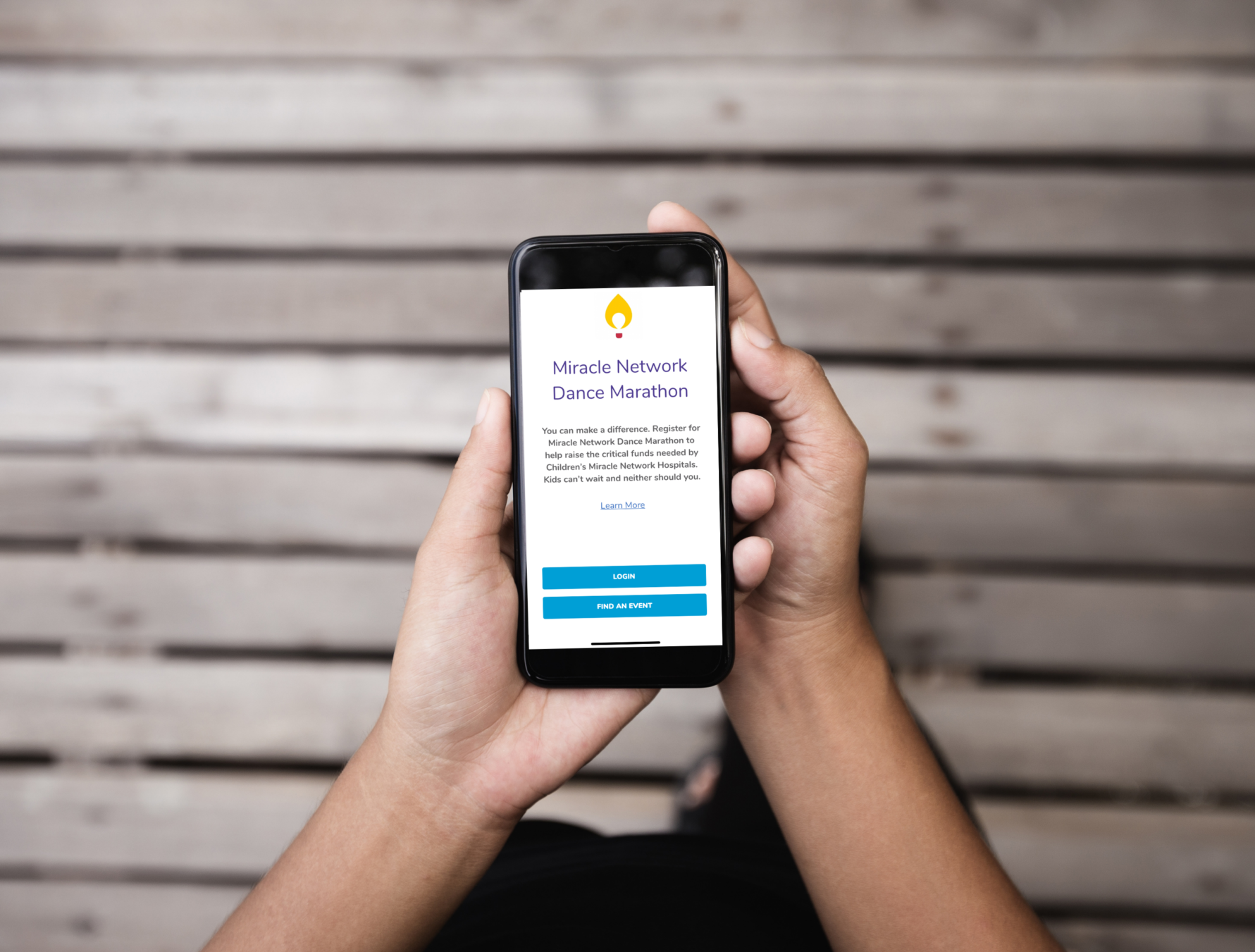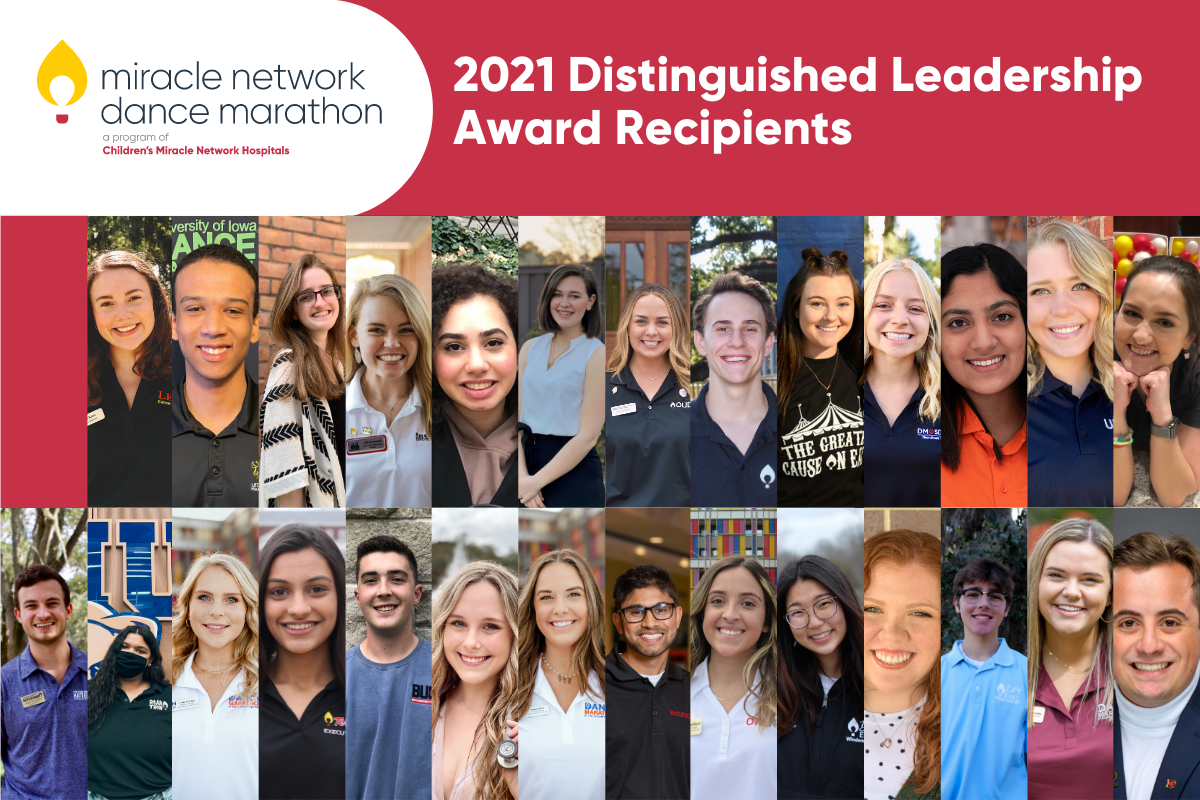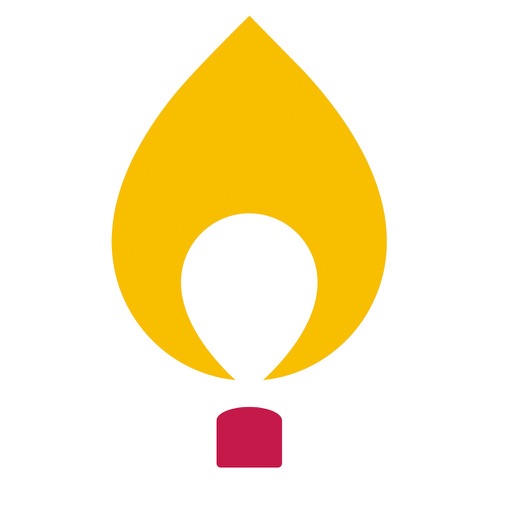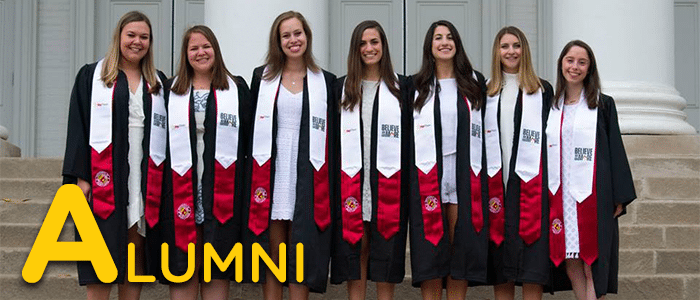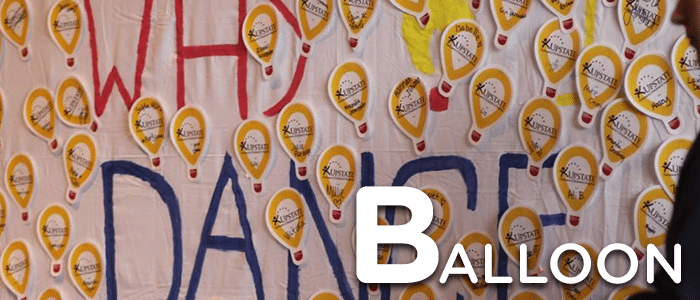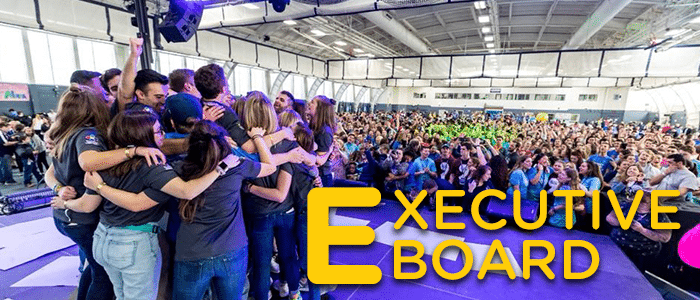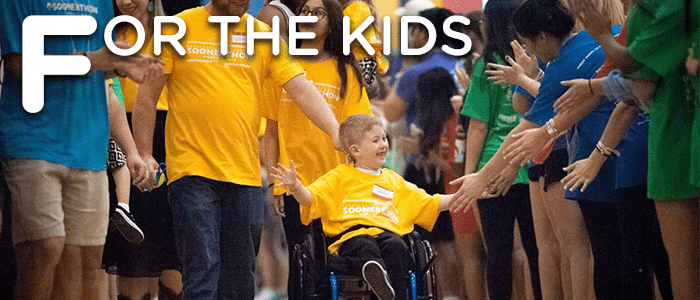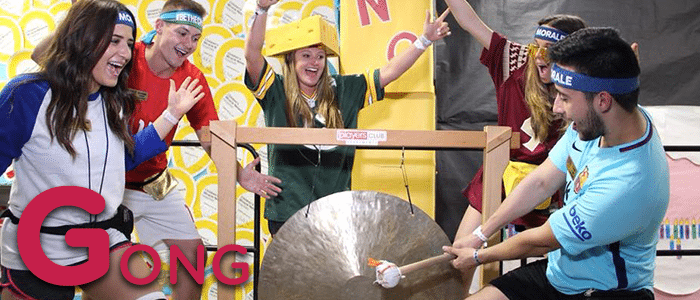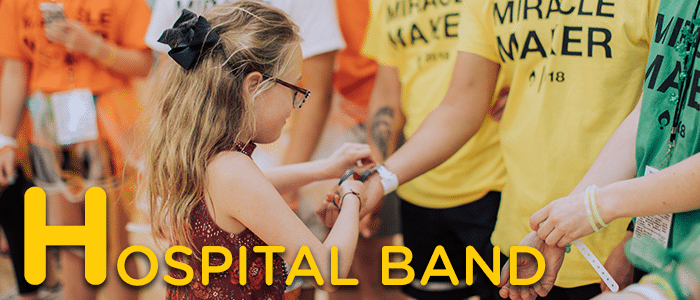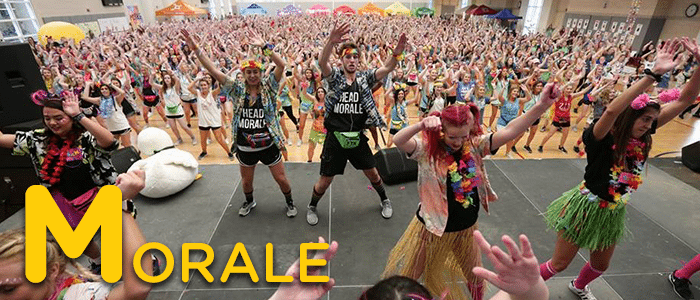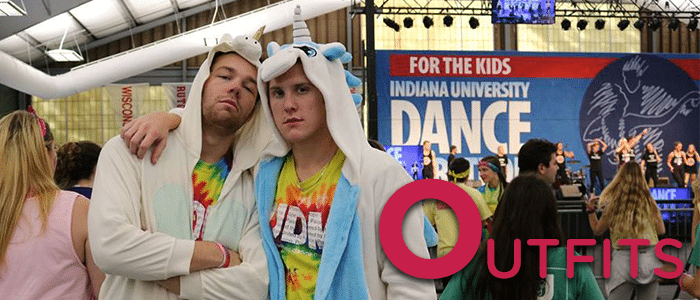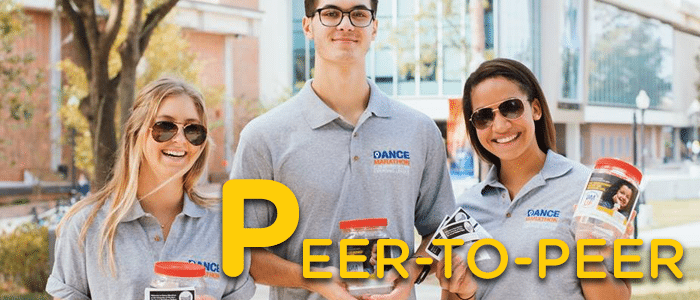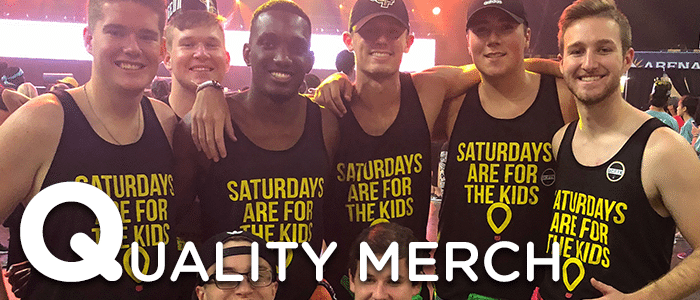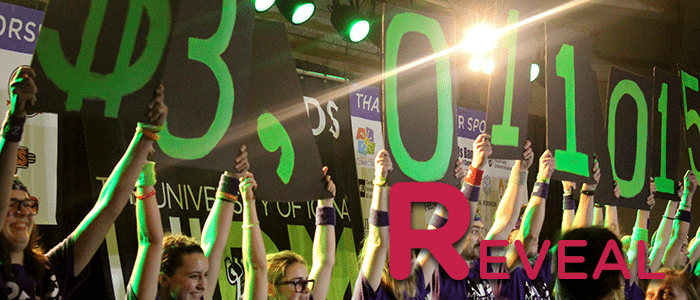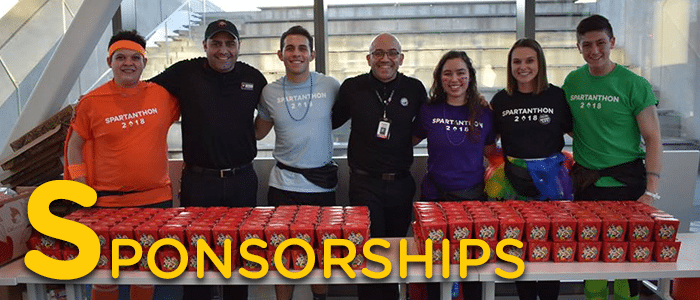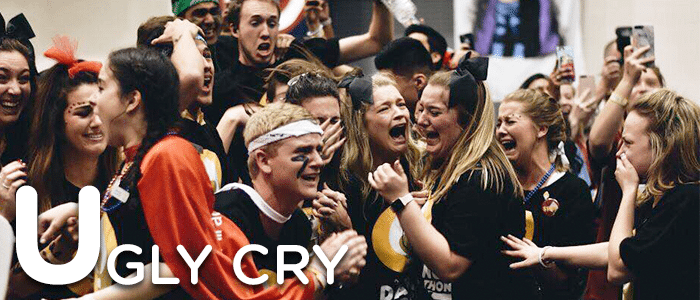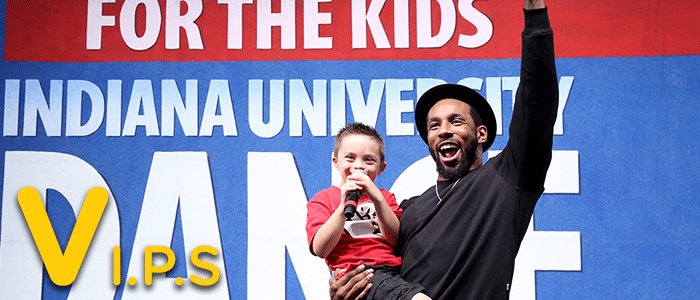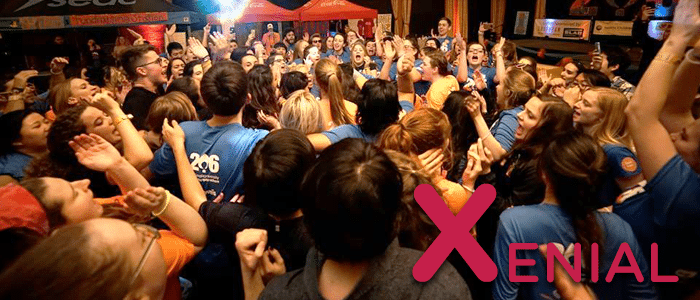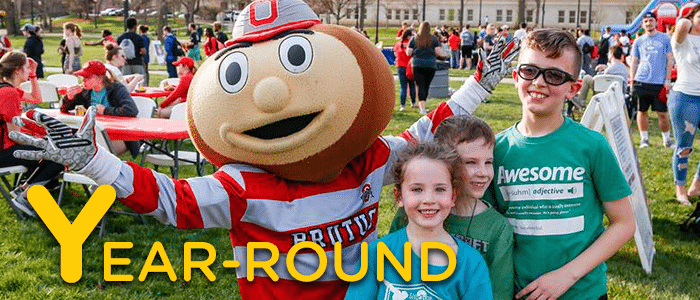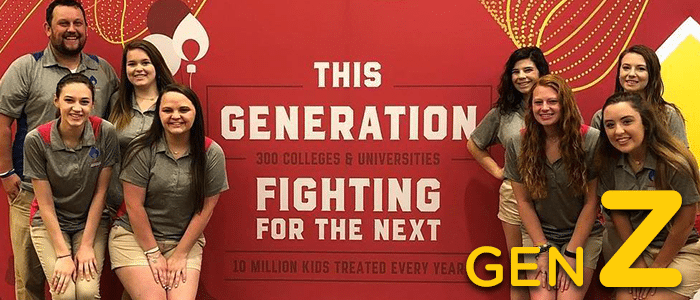ABC’s of Dance Marathon
What is Miracle Network Dance Marathon and why are they “For The Kids?” The answer is as easy as A-B-C!
Normally with the ABCs, you start from the beginning but, in this case, we’re starting at the end (of your collegiate career) with alumni! Being involved with Dance Marathon provides you with friendships that will last forever and helps students feel connected to and proud of their college or university. It’s no surprise then that many alumni look for ways to stay involved with Dance Marathon once they graduate college. Some continue to fundraise while others make donations to friends who are still involved. A number of Dance Marathon programs have official alumni groups that host meetings and alumni events, plan fundraisers, and provide mentorship to the undergraduate organization. Terp Thon’s alumni group even provided professional development opportunities for the undergraduate students, sharing resume templates and hosting a workshop about how to apply the skills learned through Dance Marathon in a professional setting.
Miracle Network Dance Marathon is an official program of Children’s Miracle Network Hospitals, which is symbolized by their hot air balloon logo. Although the design of the logo has changed since CMN Hospitals’ founding in 1983, it has always symbolized the high hopes of all children and families who benefit from donations to local children’s hospitals. The current balloon design was revealed in 2011 when Children’s Miracle Network rebranded to Children’s Miracle Network Hospitals, which was done in order to provide a more clear understanding of how CMN Hospitals’ fundraising goes directly to its local hospital partners.
You may spot the balloon logo on a campus with a dance marathon program or at many of CMN Hospitals’ corporate partners, including Walmart, Dairy Queen, Speedway, Love’s Travel Stops, IHOP, and many more. 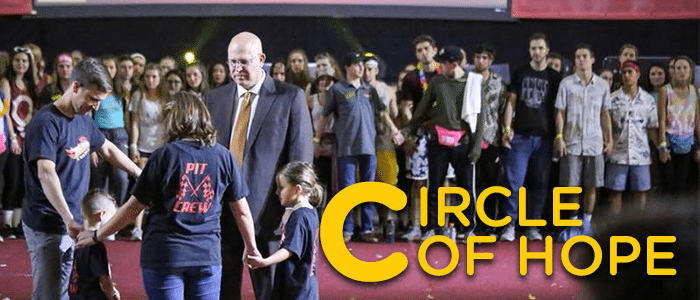
At the end of many campuses’ official dance marathon events, students will participate in what’s called a “Circle of Hope.” Students will form a circle around the room and reflect on their experience at the event. The families from the local hospital who have shared their stories at the event will stand in the middle of the circle, allowing the students to be reminded where their fundraising goes and how it affects the patients treated at the hospital. Many dance marathon programs will give hospital bands (see “H” below) to the participants and, during the Circle of Hope, the patient families will walk around the circle cutting off each students’ band, symbolizing the hospital bands that the kids get to take off once they’re able to leave the hospital after treatment. 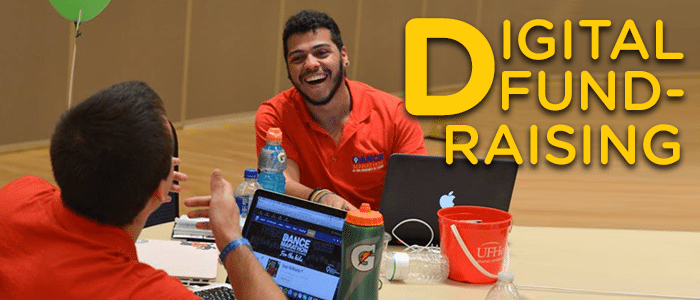
As with just about everything else in the world, dance marathon fundraising has gone digital. Students participating in fundraising through dance marathon will register on an online fundraising platform, such as Donor Drive, and send out the link to their fundraising pages to family and friends to ask for donations. Donor Drive even allows students to customize their pages to share why they’re participating, send e-mails to potential donors directly from the site, send thank you e-mails to donors, and connect their fundraising pages to their social media channels. Miracle Network Dance Marathon also launched a fundraising app in 2017 that allows participants to directly send and post pre-written out messages with your fundraising page link via text message, e-mail, Facebook, Twitter, and LinkedIn as well as enter donations directly to the mobile version of their fundraising page.
Dance marathon organizations are unique in that each campus’s organization is entirely student run. The executive boards, sometimes also referred to as an overall team or leadership team, are typically comprised of 8-20 undergraduate students who plan and implement all aspects of the organizations’ fundraising, recruitment, marketing, and strategic planning efforts. The board members often oversee committees, which provide opportunities for additional student leaders to be involved with the organization.
Many executive boards will have an Executive Director as well as positions that fall under three primary branches:
- Internal, with positions that typically oversee event planning and logistics, patient family relations, Morale (see “M” below), catering, and entertainment
- External, with positions that typically oversee marketing, social media, communications, recruitment, university relations, community events, and high school mini-marathons
- Finance, with positions that typically oversee fundraising, corporate sponsorships, budgeting, and merchandise.
Even if you’ve hardly heard about dance marathon, you probably know one thing for certain: dance marathon is For The Kids! The kids treated at local CMN Hospitals are at the core of everything dance marathon organizations do. Students participating in dance marathons are joining a movement as this generation, fighting for the next.
Funds raised by Miracle Network Dance Marathon programs stay local and go directly to the program’s local CMN Hospital. Funds are often unrestricted, allowing the hospitals to direct them to the area of greatest need (see “I” for impact below) that will allow the hospitals to provide the best treatments and services for kids and families.
Beyond fundraising, dance marathons often do so much more for their Miracle kids and patient families. When a kid comes to a dance marathon event, they are treated like a rock star. They often welcomed into the events through a tunnel of cheering students and are given their time to shine on stage as they share their story or perform a talent. These kids are viewed as kids first and are able to forget about their conditions or treatments for a day. Dance marathon students often form deep relationships with the kids they meet and will support them throughout the year by celebrating their birthdays, attending their soccer games or dance recitals, and sending them words of encouragement before an upcoming treatment.
The tradition of hitting a gong during a dance marathon event was started by Dance Marathon at Florida State University several years ago as a way to incentivize participants for fundraising during their event. For every $100 raised, participants got to come up to a side stage to hit the gong and be cheered on by their peers. DM at FSU says that the sounds of a gong has become the heartbeat of their marathon, with each hit symbolizing another healthy heartbeat made possible through funds raised. This tradition has spread throughout the movement with campuses all over the nation incorporating a gong into their events. Some campuses have adapted the idea to utilize another sound such as an airhorn or a sound related to campus-specific traditions. Purdue University Dance Marathon, for example, plays the sounds of a train horn for every $100 raised as a nod to their mascot, the Boilermakers.
Just as a pediatric patient would have a hospital band put on their wrist as they enter the hospital for treatment, dance marathon participants are often given similar hospital bands as a reminder of who they’re fundraising for. Students will sometimes write the name of a specific patient they’ve met who they’re fundraising in honor of. At the end of a dance marathon event, participants will have their hospital band cut off, symbolizing the hospital bands that the kids get to take off once they’re able to leave the hospital after treatment that will be able–made possible, in part, thanks to donations to the hospital.
To order a free CMN Hospitals hospital band, click here!
Funds raised through Miracle Network Dance Marathon programs are truly making a tangible impact at local Children’s Miracle Network Hospitals throughout North America. Every dollar that’s raised by a dance marathon program stays local to directly support the CMN Hospital in their community. Donations are often unrestricted, helping to support the area of greatest need at the hospital.
According to CMN Hospitals, funds raised make an impact by supporting uncompensated care (13%), equipment (25%), research (12%), education (7%), special services (15%), and custom needs (28%). These percentages are averaged from all member hospitals.
Numerous Dance Marathon organizations have been able to see their funds in action. The University of Iowa Dance Marathon recently announced funds raised in their 24th annual Dance Marathon event will go towards a brand new, state of the art 3T MRI (magnetic resonance imaging) machine – a bill that would cost the their local CMN Hospital, University of Iowa Stead Family Children’s Hospital, over $650,000. In return for their donation, the waiting room will be named “University of Iowa Dance Marathon Waiting Room.”
Children’s Healthcare of Atlanta recently named its comprehensive inpatient rehabilitative unit gym the “UGA Miracle Gym,” after University of Georgia’s Dance Marathon, known as UGA Miracle, surpassed the $1M mark in their annual fundraising for the first time in 2016. Aside from the improved equipment and spaces that their fundraising has helped provide, UGA Miracle impacts future generations of doctors as their fundraising also supports Aflac Cancer and Blood Disorders Center to fund groundbreaking pediatric research.
Gonzaga University Dance Marathon’s fundraising helped provide life critical equipment for Providence Sacred Heart Medical Center and Children’s Hospital, including a children’s vein finder for IV starts ($27,649), neonatal intensive care unit (NICU) developmental position of premature infants ($2,090), a 3D heart of an infant patient for training ($1,625), children’s hospitals security equipment ($11,060) and NICU aspiration prevention equipment ($540).
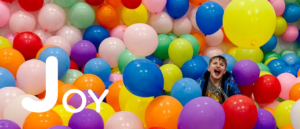
Whether it is the joy on a miracle kid’s face as they run into the event, the joy a participant feels after receiving a donation, or the joy in the room following the total reveal, it can be said that a Dance Marathon is one of the most joyous events around. As a celebration of the year and of all the miracles that your program has made over the past year, happiness is tangible in every event space.
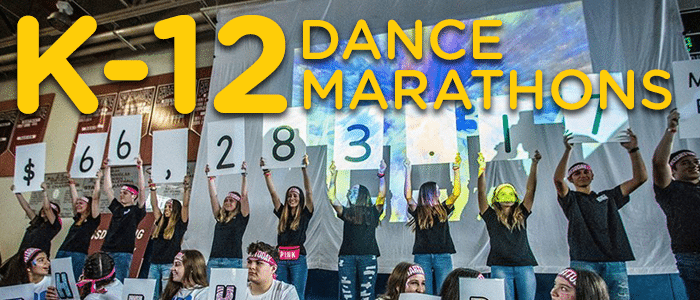
The Miracle Network Network Dance Marathon movement is not limited to colleges and universities. In fact, hundreds of K-12 schools throughout the U.S. and Canada host dance marathons at their schools. Some K-12 school events operate independently, with their total going directly to their local hospital. Others, however, operate as “mini-marathons,” falling under their local collegiate dance marathon organization. The collegiate dance marathon student leaders will often work to reach out to local K-12 schools to acquire new dance marathon programs and will support and mentor the students involved throughout the planning process. The total that the mini-marathons raise then gets included in the collegiate Dance Marathon’s overall total.
Mini-marathons also provide a great opportunity for high school students to connect with a nearby college or university and develop relationships with college students as they prepare for their own transition to college. Jagathon at IUPUI even partnered with their campus’s admissions office to provide funding and admissions resources to their mini-marathon programs.
The Miracle Network Dance Marathon record for the highest fundraising mini-marathon is held by Carmel High School in Carmel, Indiana which fundraised $453,935 at their March 2018 event. Their program is supported by Indiana University Dance Marathon, which fundraises for Riley Hospital for Children in Indianapolis.
The record for the highest fundraising first-year dance marathon was broken in April 2018, when Dance Marathon at Marjory Stoneman Douglas High School in Parkland, Florida fundraised $66,283.17 in their inaugural year.
The experience gained from serving as a student leader in a dance marathon program is unparalleled to any other leadership opportunity on a campus. Dance marathon student leaders work on teams with their peers, delegate tasks, oversee committees, communicate with internal and external stakeholders (including campus administrators, local businesses, patient families, hospital foundation staff members, and community members), manage five- to six-figure budgets, make pitches for donations and corporate partnerships, plan and execute events, recruit new participants, train incoming leaders, and more. Any student involved in a dance marathon learns valuable soft skills such as communication, public speaking, collaboration, and problem-solving, leaving them more than prepared to enter the job force upon graduation.
Each year, Miracle Network Dance Marathon recognizes the top twenty graduation seniors with the Miracle Network Dance Marathon Distinguished Leadership Award. The recipients are recognized for making an exceptional impact within their Dance Marathon program, on their individual campus and for their local Children’s Miracle Network Hospital.
CMN Hospitals also hosts an annual Dance Marathon Leadership Conference, which brings together nearly 1,000 student leaders and university and hospital staff members for a weekend of collaboration, best practice sharing, leadership development, and educational programming.
Morale is the official “hype man” of the Miracle Network Dance Marathon movement. Morale is two things: a committee and a dance. The Morale committee works throughout the year to bring energy and enthusiasm to their organization. They help to recruit new participants, encourage participants in their fundraising, and be a welcoming face to their organization. On many campuses, Morale committees will help to facilitate color group wars, where participants are divided into different color groups and compete in fundraising challenges and activities. The committee also helps to choreograph a morale dance, or line dance, that they will teach participants at the dance marathon event. Throughout the 8-36 hours, the Morale committee will teach the dance, which is usually performed at the top of each hour as a way to keep participants excited and engaged. The Morale committee often also facilitates different themed hours during the dance marathon and coordinates activities for participants to engage in.
The coolest part about Miracle Network Dance Marathon is the international network that is created between colleges, universities, and K-12 schools throughout North America. There are very few opportunities for students that allow them to develop meaningful relationships with students on other campuses, collaborating and sharing ideas to help their organizations grow in their fundraising efforts.
While rivalries may exist between campuses on the athletic fields, dance marathon programs are utilizing those rivalries to their advantage with friendly fundraising and awareness competitions. Dance marathons celebrate the success of other programs and admire what they can accomplish together, united under the same goal.
Student leaders will often attend dance marathon events at nearby campuses to show their support and get new ideas. They’ll attend collaboration forums with other dance marathon programs that benefit their same local hospital. They ask questions and share best practices through Facebook groups and GroupMe.
Miracle Network Dance Marathon is a movement that is taking over the nation with a presence in nearly every state, collegiate athletic conference, and making a difference for students at over 400 colleges, universities, and high schools throughout North America.
Walking through a dance marathon event, you’re certain to see some interesting outfits you might not see on an average day on campus. Tutus, fanny packs, neons, face paint and more are certainly fashionable for many participants. Programs will often host theme hours throughout their event, where participants can change into fun costumes, dance to themed music or participant in themed activities. Themes have included famous pairs, Skype interview (business attire on top, pajamas on bottom), ski lodge, DM 3018 (futuristic), ESDM (rock your favorite jersey), wigging out (rock your favorite wig), kids birthday party, and more!
On average, 90% of a Miracle Network Dance Marathon program’s fundraising total comes from students engaging in peer-to-peer fundraising, where they set up a fundraising website and ask their friends and family to make donations, with most donations being $20 or less. Students set personal fundraising goals and many programs provide incentives for students who reach specific milestones, including inducting students who raise over $1,000 into the “Comma Club,” recognizing the comma they’ve added to their individual fundraising total.
Miracle Network Dance Marathon was named the 14th largest peer-to-peer fundraising program in the nation in 2017 by the Peer-to-Peer Professional Forum, in conjunction with Charity Dynamics. While a majority of the programs on the list saw a decrease in fundraising in 2017, Miracle Network Dance Marathon received a special shout out as the fastest growing peer-to-peer program, increasing fundraising by 19.6% over the previous year to nearly $39 million.
Beyond sending messages to family and friends, some students will also participate in “canning,” where they’ll take a can out on campus or in the community. Others will offer services such as rides to class, sell crafts, or offer to post embarrassing photos or videos of themselves in exchange for donations.
Dance marathon programs often share fundraising tips with participants to help them increase their individual fundraising totals (example: DM at FSU Fundraising Packet).
Because you can never have enough t-shirts, right? Dance marathon participants can be easily spotted on campus likely wearing some form of quality “for the kids” merchandise to class on a nearly daily basis. Programs will sell merchandise as a way to raise funds toward their overall fundraising total and to help spread awareness about their organization on campus.
In 2018, Luther College Dance Marathon was recognized with the Best Merchandise Award at the Dance Marathon Leadership Conference. Their merchandise was truly created with the kids in mind, leading them to came up with a “For the Kids, By the Kids” merchandise strategy. Their merchandise was all created by their Miracle kids. They sold hats with “For The Kids” printed in one of their kids’ handwriting and t-shirts with a self portrait drawn by one of their Miracle kids who had previously passed away.
Be sure to check out Miracle Mall to get your own Miracle Network Dance Marathon and CMN Hospitals merch!
It’s the moment everyone has been waiting for. The reveal of the fundraising total, which takes place at the end of every dance marathon event. The total revealed represents everything that has been fundraised by participants throughout the previous year and represents the amount that will be donated to the programs’ local CMN Hospitals. So it’s no wonder that the reveal is done in a dramatic and highly anticipated fashion.
With the numbers of the total written on the back of poster boards, students will often reveal the final total one number at a time, with the participants eagerly awaiting the culmination of their efforts. The reveal comes with a wave of emotion (see “Ugly Cry” below) and a sense of pride as a visual representation of the students’ hard work.
In addition to peer-to-peer fundraising efforts, dance marathon programs also seek support from corporate sponsorships with local businesses who make either monetary or in-kind donations to help the students cut down the costs of their programming, therefore increasing the donation they’re able to make to their local hospital. Programs will often work with local businesses in their communities, some of which may also have an established relationship with their local hospital. Student leaders will also work with local restaurants to host give-back nights where a portion of the proceeds will be donated to the dance marathon program.
Dance marathons work to create sponsorship packets (ex. DM at UF) with different sponsorship levels (ex. University of Iowa Dance Marathon) to recognize and provide value to their partners.
On a national level, Miracle Network Dance Marathon has partnerships with Love’s Travel Stops & Country Stores, Panda Express, Delta Air Lines, and Aflac, each of which are partners of CMN Hospitals. These partners select a certain number of collegiate programs to support with monetary donations that are used to cover operating expenses that will help the programs market themselves, implement their events, and increase fundraising.
Dance marathon provides a fun opportunity for students to fundraise and participate in their event on teams with their friends. Teams are often created by fraternities, sororities, residence halls, student organizations, athletic teams, and groups of friends. The highest fundraising teams are often recognized at the end of a dance marathon event. Teams will have a team captain that can relay information from the dance marathon organization to the rest of their team members and will help their teammates with their fundraising.
In 2017, sorority teams raised over $8.6 million and fraternity teams raised over $3 million collectively nationwide.
When you’ve worked hard throughout the entire year, dedicated countless hours to fundraising and preparing for a dance marathon, and been at an event for 8-36 hours, you’re allowed to have an “ugly cry” moment when the annual fundraising total is revealed. Some of us are just lucky enough to have that moment captured in photos as well. Rather than explaining it, it’s just something that’s better to see below, courtesy of the Purdue University Dance Marathon executive board.
https://www.facebook.com/CMNHospitalsDM/videos/2026851354197768/
Some dance marathon programs have had the opportunity to have some awesome VIP’s attend their events over the years.
Miracle Network Dance Marathon has been proud to have the incredible support of tWitch (Ellen, So You Think You Can Dance) and Allison Holker (So You Think You Can Dance, Dancing with the Stars), who have helped to raise awareness about dance marathon and been a great source of encouragement for the movement. tWitch got to attend his first dance marathon event at Indiana University in 2016 and was immediately sold on the cause. He and Allison attended the 2017 Dance Marathon Leadership Conference to judge the Morale Dance Showcase and Allison returned in 2018 to host the showcase.
Individual programs have had their own VIPs show support for their cause. Most recently Drake gave a shout out to HuskyTHON after they raised $1 million in February 2018.
Even if you don’t know your “why” when you first get involved in a dance marathon program, you will certainly find it very quickly. Students will often have to explain why they participate in Dance Marathon, whether they’re recruiting friends to participate or asking for donations.
Some participate because they themselves were treated at a local children’s hospital. Others know a friend or a family member who has had an experience at a hospital. They’ve seen first-hand the impact that donations can have on the kids and families treated by a local CMN Hospital. Others have had the opportunity to meet the Miracle kids and families at a dance marathon event and be inspired by their stories.
Dance marathon does more than impact the hospital with their fundraising, they’re also having a lasting impact on the kids and families that they get to interact with.
Ok, give us a break here. X is a really hard letter, right?
According to Meriam Webster, xenial is an adjective meaning “of, relating to, or constituting hospitality or relations between host and guest.” After a Google search of “words starting with x,” xenial seemed like a perfect descriptor of Dance Marathon!
Dance marathon students are some of the friendliest people you’ll meet on a campus! While they may sometimes come across as a little overly excited, outgoing, loud, and positive, it is all with the best intentions. They want you to experience the incredible power of Dance Marathon and give you the same life-changing experience they’ve had.
Dance Marathon provides an opportunity for anyone on a campus to come together and be united under one common cause–to support the kids treated in their local community. New participants are welcomed with open arms and everyone should be able to find a place in this movement.
While a lot of the attention is focused on the actual Dance Marathon event, dance marathon programs work year-round to raise funds and awareness.
Programs will often host special events throughout the year as fundraisers or opportunities to engage different members of campus. Many programs host kick-off events and participate in their campus’s involvement fair at the start of the school year. They sponsor informational sessions and attend student organization meetings to recruit new students and teach them about dance marathon. Programs sometimes set-up regular meetings for participants to come to to learn about how they can fundraise and get more involved.
On Child Health Day, which will be held on October 3 in 2018, dance marathon programs challenge students on their campus to #CommitForTheKids by joining dance marathon, making a donation, or spreading the word that children’s hospitals need donations.
Dance marathon programs also frequently host fundraising push days, where they will rally their campus together to raise a certain total in a 24-hour period in order to create some excitement and urgency for their efforts. For example, in November 2017, three Florida universities each held their fundraising push days one one day, collectively raising over $1 million.
Students in high school in college are all members of Generation Z, defined as people born from the mid-1990s to the early 2000’s. Members of Generation Z have been described as comfortable with technology and social media, entrepreneurial and better multi-taskers, more global and committed to social change.
The Guardian referred to Generation Z as “philanthroteens,” committed to making the world better with a willingness to get involved to make it happen. 32 percent of Gen Z donate their own money, 26 percent of 16 to 19-year-olds practice volunteering on a regular basis, 50 percent are looking for a job in volunteering, and 10 percent want to start their own nonprofit organization.
It’s no surprise then why Miracle Network Dance Marathon is the fastest growing peer-to-peer fundraiser in the nation. Dance Marathon organizations, run entirely by 13-22 year old high school and college students, activate their following by empowering each individual to realize the difference they can make in their community, not only giving them an outlet to do so, but also communicating the impact of that difference back to them. This humanizes the issue, even if a supporter has never been directly impacted by a local children’s hospital.
These young people aren’t just hosting philanthropic events on their campuses – they’re harnessing a movement. They are this generation, fighting for the next.
Miracle Network Dance Marathon is an international movement, involving over 400 colleges, universities and K-12 schools across North America that fundraise for their local Children’s Miracle Network Hospitals. Since its inception in 1991, Miracle Network Dance Marathon has raised more than $250 million–ensuring that no child or family fights pediatric illness or injury alone.
Learn more about Miracle Network Dance Marathon:

